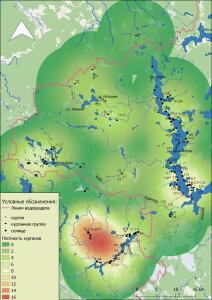 Alexei L. Smirnov1,*, Maksim Yu. Menshikov1,**, Maksim V. Bobrovsky2,***, Dmitry A. Kupriyanov1,****, Ekaterina A. Kleshchenko1,*****, Alexei V. Tiunov3,*******, Maria V. Dobrovolskaya1,********
Alexei L. Smirnov1,*, Maksim Yu. Menshikov1,**, Maksim V. Bobrovsky2,***, Dmitry A. Kupriyanov1,****, Ekaterina A. Kleshchenko1,*****, Alexei V. Tiunov3,*******, Maria V. Dobrovolskaya1,********
1Institute of Archaeology RAS, Moscow, Russia
2Institute of Physical, Chemical and Biological Problems of Soil Science RAS, a division of Pushchino Centre for Biological Research RAS, Pushchino, Russia
3A.N. Severtsov Institute of Ecology and Evolution RAS, Moscow, Russia
*E-mail: ari1828@bk.ru
**E-mail: maxim-menshikov@yandex.ru
***E-mail: maxim.bobrovsky@gmail.com
****E-mail: dmitriykupriyanov1994@yandex.ru
*****E-mail: malzeva-ekaterina@mail.ru
*******E-mail: a_tiunov@mail.ru
********E-mail: mk_pa@mail.ru
Keywords: settlement, the upper Volga and Western Dvina regions, Okovets forest, Early Iron Age, Middle Ages, GIS, laser survey.
The study of the historical dynamics of settlement in the upper Volga and Western Dvina regions near the Valdai watersheds was conducted based on records of archaeological sites of the Early Iron Age, early Middle Ages and Rus period. A database was created using archival data, the register of the “Archaeological Map of Russia” and survey results. The authors employed capabilities of geographic information systems (QGIS software, heatmap analysis tool), as well as laser scanning conducted with an unmanned aerial vehicle. The research substantiates the settlement of the microregion in the early Iron Age by groups of carriers of the Dyakovo culture traditions. The second half of the 1st millennium is characterized by an active spreading of sites attributed mainly to the Pskov long barrow culture which reflect a different settlement pattern and location of sites within the relief. In Rus period, against the background of the expansion of sites, it is possible to observe their concentration in the locations of “transport hubs” (watersheds, contact of river basins). The study revealed a new category of site for this territory – stone clusters which find analogies in the antiquities of the Ladoga region.
DOI: 10.31857/S086960630013168-3







